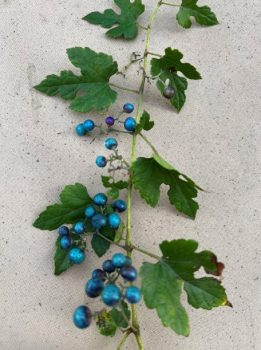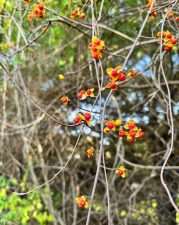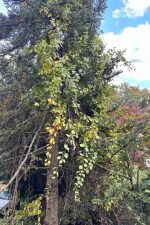Before describing two invasive vines, let us consider what makes a non-native plant (also known as an alien plant) invasive and why we should care. An invasive plant must meet two basic criteria:
- humans have deliberately or accidentally introduced it into an area where it did not evolve, and
- it must be ecologically or economically harmful to the areas where introduced.
These are common traits of invasive plant species:
- They grow, mature, and spread quickly.
- They produce and disperse copious seeds.
- They out-compete native species for critical resources including light, water, and nutrients.
- They require significant amounts of time, energy, and/or money to control.
Importantly, invasive species are not functioning members of the local ecosystem. They are neither susceptible to most local plant diseases nor palatable to insects. Both vines described here were imported from eastern Asia in the latter half of the 19th century for their

Porcelain berries found near the intersection of Central and Oakmont Avenues.
attractive ornamental berries and their ability to grow quickly on structures. Unfortunately, both are still available in commerce. Fortunately, few of these plants are in Washington Grove, providing us the opportunity to prevent their establishment. If you notice one of these vines on Town land, it would be very helpful if you contact either the F&B Committee (in the residential area email Georgette at [email protected]) or the Woods Committee (in the East or West Woods email Joan at [email protected]).
Porcelain Berry (Ampelopsis brevipedunculata)
Porcelain berry is a member of the grape family (Vitaceae). This deciduous, woody vine develops thick, vast root networks and can grow more than 20 feet tall if trees and shrubs are available for climbing. Its tiny white flowers bloom in mid-summer followed by the colorful transformation of its berries from white to yellow, lilac, green and metallic turquoise. Although the leaves may look like other members of the grape family, there is no mistaking the berries for grapes. Birds and small mammals spread this plant over long distances by eating its fruits. Porcelain berry also reproduces asexually by re-sprouting from roots.
Porcelain berry grows in almost all habitats and particularly well in damp, partially shady areas such as near water bodies, forest edges, and within thickets. The vine can completely engulf and shade out native trees and shrubs. It has the tendency to become a monoculture, thus reducing biodiversity in the habitats that it invades.

Oriental bittersweet growing on the highway fence in lower Piedmont Crossing Park
Roundleaf or Oriental Bittersweet (Celastrus orbiculatus)
Celastrus orbiculatus is a member of the bittersweet family (Celastraceae). This deciduous, perennial, woody vine can grow up to 60 feet tall and 10 inches in diameter. Its round or elliptical-shaped leaves are usually three to four inches in length. Fruits have yellow skins that peel back in the fall and reveal bright red berries. These berries remain in the winter after foliage has dropped. Oriental bittersweet is dioecious, meaning that pollen and fruits must come from separate male and female plants. This requirement for cross-fertilization forms the basis for the greatest danger of oriental bittersweet invasion: its ability to hybridize with American bittersweet (C. scandens). Hybridization is the interbreeding of two plants that are genetically different, which may increase the invasiveness of a plant by improving its ability to adapt in areas where it is introduced. Invasive bittersweet is so successful that the genetic identity of our native American bittersweet could become lost, leading to the extinction of the native species. Like other invasive vines, C. orbiculatus outcompetes native vegetation. If left unchecked, it can strangle and kill large trees.

Oriental bittersweet climbing a Norway spruce in Blacksburg Virginia
A range of environments is suitable for oriental bittersweet to thrive, from forested areas near streams to thickets and roadsides with a preference for full sun. In shaded areas the vine will climb trees and shrubs to gain better access to light.
Management
Because both porcelain berry and oriental bittersweet are perennial, woody, deciduous vines, removal methods are nearly identical. Seedlings can be removed by hand, larger vines by shovel or, preferably, by spade to rip roots. Be sure to remove and dispose of the entire root network, or else the vines can grow back from root fragments. Never compost these plants. There are times when the use of herbicides may be necessary. A combination of cutting followed immediately by application of glyphosate to the stump is reported to be the most effective in ensuring control. Chemical and mechanical methods should be applied before the plants fruit because seeds can be spread by birds or remain in the soil seed bank for years. As such, seedlings need to be removed yearly until the seed bank is depleted.
